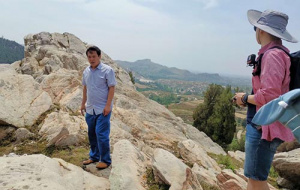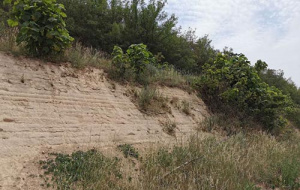From Shanghai to Henan
 Old Members’ Trust Graduate Travel Fund Report – Muyang Shi
Old Members’ Trust Graduate Travel Fund Report – Muyang Shi
Travel in the Time of Covid-19: A six-day fieldtrip from Shanghai to Henan
The first half of 2020 has proven itself to be one of the toughest times to conduct any field-based research and, with almost all excavations around the world cancelled, archaeology is no exception. However, thanks to the diligent work of doctors, nurses, volunteers and billions of Chinese civilians who chose to stay at home and wear masks in public, the outbreak of Covid-19 was already under control in mainland China by the beginning of June. With the generous support of the Old Members Trust Travel Grant, I was fortunate enough to carry out a 6-day fieldtrip, starting June 5th., to Henan where I delivered a presentation at Zhengzhou University, visited numerous archaeological sites in the broader Zhengzhou Plains and local archaeologists at the Henan Provincial Institute of Cultural Heritage and Archaeology.
I always knew this would not be an easy trip and took extra cautions ever since I left my home in Shanghai. One of the key items I had with me at all times was my mobile phone, not for keeping in touch with loved ones but for showing my personal Health Code – a real-time QR code that reflected my travel history and health condition with a simple green, yellow or red differentiation. And, of course, whether at a train station or a small grocery store, I always wore a mask. In fact, the first time that I ever took my mask off in a closed space with more than two people was during my presentation at Zhengzhou University, where one technician, two professors and four students sat evenly across the lecture room that could host 60 at a time.
 Fortunately, the hour-long presentation of my MPhil thesis went well. Roughly 50 people participated online in my sharing of the research on assessing prehistoric conflict among Iron Age hillforts in Southern Britain, it was perhaps an audience that I might not have been able to attract in a face-to-face setting. Particularly fruitful – and in a way, surreal – was the conversation with Prof. Hui after the presentation in which we almost had to shout to each other back and forth across the near-empty room to discuss methods that effectively unite datasets of different qualities and sources.
Fortunately, the hour-long presentation of my MPhil thesis went well. Roughly 50 people participated online in my sharing of the research on assessing prehistoric conflict among Iron Age hillforts in Southern Britain, it was perhaps an audience that I might not have been able to attract in a face-to-face setting. Particularly fruitful – and in a way, surreal – was the conversation with Prof. Hui after the presentation in which we almost had to shout to each other back and forth across the near-empty room to discuss methods that effectively unite datasets of different qualities and sources.
 As the view around me shifted from skyscrapers to farmhouses, the transition between the urban and the countryside was especially dramatic. Walking from a Late Neolithic settlement with rammed earth walls to another back-filled site with raised platforms, I used the GPS function in my phone far more often than the Health Code, and the most imminent health risk was not the possibility to contract Covid-19 but heatstroke from hours of walking under the scorching sun of early-summer Henan. But it was not all bad. Perhaps owing to the hot weather and pausing of excavation plans, I had little issue scheduling a meeting with local archaeologists, and their less-packed timetable allowed plenty of time for in-depth conversations. Thanks to the generous hospitality these local archaeologists and professors at Zhengzhou University, I managed to achieve all research objectives two days before planned, and therefore returned to Shanghai in the evening of June 10th.
As the view around me shifted from skyscrapers to farmhouses, the transition between the urban and the countryside was especially dramatic. Walking from a Late Neolithic settlement with rammed earth walls to another back-filled site with raised platforms, I used the GPS function in my phone far more often than the Health Code, and the most imminent health risk was not the possibility to contract Covid-19 but heatstroke from hours of walking under the scorching sun of early-summer Henan. But it was not all bad. Perhaps owing to the hot weather and pausing of excavation plans, I had little issue scheduling a meeting with local archaeologists, and their less-packed timetable allowed plenty of time for in-depth conversations. Thanks to the generous hospitality these local archaeologists and professors at Zhengzhou University, I managed to achieve all research objectives two days before planned, and therefore returned to Shanghai in the evening of June 10th.
Once again, I could not have done the trip without support from local contacts in Zhengzhou and Univ’s Old Members, and it is to them that I would like to extend my most sincere gratitude.
Find out more about the range of travel grants and scholarships available to assist Univ students on our Travel Grants page or read further travel reports.
